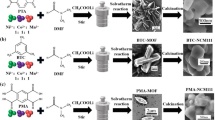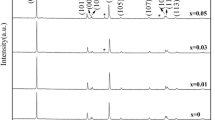Abstract
The LiNi1−yMyO2 specimens with compositions of LiNiO2, LiNi0.975Ga0.025O2, LiNi0.975Al0.025O2, LiNi0.995Ti0.005O2, and LiNi0.990Al0.005Ti0.005O2 were synthesized by wet milling and a solid-state reaction method. Among all the specimens, LiNi0.990Al0.005Ti0.005O2 has the largest first discharge capacity of 196.3 mAh/g at a rate of 0.1 C. At n=50, LiNiO2 has the largest discharge capacity of 126.7 mAh/g. LiNiO2 has the best cycling performance, its degradation rate of discharge capacity being 0.73 mAh/g/cycle. LiNi0.975Al0.025O2 shows the lowest decrease rate of the first discharge capacity with C rate. An equation describing the variation of the discharge capacity with the number of charge-discharge cycles, n, is obtained. The Williamson-Hall method is applied to calculate the crystallite size and the strain of the samples before and after charge-discharge cycling.
Similar content being viewed by others
References
J. M. Tarascon, E. Wang, F. K. Shokoohi, W. R. McKinnon, and S. Colson, J. Electrochem. Soc. 138, 2859 (1991).
A. R. Armstrong and P. G. Bruce, Lett. Nature 381, 499 (1996).
M. Y. Song and D. S. Ahn, Solid State Ionics 112, 245 (1998).
K. Ozawa, Solid State Ionics 69, 212 (1994).
R. Alcántara, P. Lavela, J. L. Tirado, R. Stoyanova, and E. Zhecheva, J. Solid State Chem. 134, 265 (1997).
Z. S. Peng, C. R. Wan, and C. Y. Jiang, J. Power Sources 72, 215 (1998).
J. R. Dahn, U. von Sacken, and C. A. Michal, Solid State Ionics 44, 87 (1990).
J. R. Dahn, U. von Sacken, M. R. Jukow, and H. Aljanaby, J. Electrochem. Soc. 138, 2207 (1991).
D. H. Kim and Y. U. Jeong, Korean J. Met. Mater. 48, 262 (2010).
H. U. Kim, D. R. Mumm, H. R. Park, and M. Y. Song, Electron. Mater. Lett. 6, 91 (2010).
Y. Nishida, K. Nakane, and T. Stoh, J. Power Sources 68, 561 (1997).
J. Morales, C. Perez-Vicente, and J. L. Tirado, Mat. Res. Bull. 25, 623 (1990).
A. Rougier, I. Saadoune, P. Gravereau, P. Willmann, and C. Delmas, Solid State Ionics 90, 83 (1996).
M. Guilmard, A. Rougier, M. Grune, L. Croguennec, and C. Delmas, J. Power Sources 115, 305 (2003).
M. Y. Song, R. Lee, and I. H. Kwon, Solid state Ionics 156, 319 (2003).
Y. Gao, M. V. Yakovleva, and W. B. Ebner, Electrochem. Soldi-State Lett 1, 117 (1998).
S. H. Chang, S. G. Kang, S. W. Song, J. B. Yoon, and J. H. Choy, Solid State Ionics 86–88, 171 (1996).
M. Guilmard, L. Croguennec, and C. Delmas, J. Electrochem. Soc. 150, 1287 (2003).
J. N. Reimers, E. Rossen, C. D. Jones, and J. R. Dahn, Solid State Ionics 61, 335 (1993).
R. Kanno, T. Shirane, Y. Inaba, and Y. Kawamoto, J. Power Sources 68, 145 (1997).
G. Prado, E. Suard, L. Fournes, and C. Delmas, J. Mater. Chem. 10, 2553 (2000).
E. Chappel, G. Chouteau, G. Prado, and C. Delmas, Solid State Ionics 159, 273 (2003).
D. Tong, J. Cao, Q. Lai, A. Tang, K. Huang, Y. He, and X. Ji, Materials Chemistry and Physics 100, 217 (2006).
A. Yu, G. V. Subba Rao, and B. V. R. Chowdari, Solid State Ionics 135, 131 (2000).
H. U. Kim, S. D. Yoon, J. C. Lee, H. R. Park, C. G. Park, and M. Y. Song, J. Kor. Ceram. Soc. 42, 631 (2005).
H. U. Kim, S. D. Yoon, J. C. Lee, H. R. Park, and M. Y. Song, J. Kor. Ceram. Soc. 42, 352 (2005).
T. Ohzuku, A. Ueda, and M. Nagayana, J. Electrochem. Soc. 140, 1862 (1993).
J. Kim and J. Amine, J. Power Sources 104, 33 (2002).
C. Suryanarayana and M. Grant Norton, X-ray Diffraction, A Practical Approach, pp.207–222, Plenum Press, New York (1998).
Author information
Authors and Affiliations
Corresponding author
Rights and permissions
About this article
Cite this article
Song, M.Y., Mumm, D.R., Park, C.K. et al. Cycling performance of LiNi1−yMyO2 (M=Ni, Ga, Al and/or Ti) synthesized by wet milling and solid-state method. Met. Mater. Int. 18, 465–472 (2012). https://doi.org/10.1007/s12540-012-3013-3
Received:
Accepted:
Published:
Issue Date:
DOI: https://doi.org/10.1007/s12540-012-3013-3




